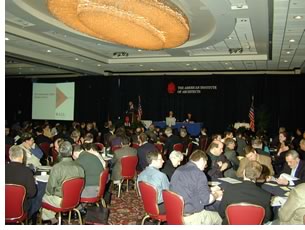

Best Practices Research, More Services for
Young Architects, Ad Campaign
New technology in the form of individual electronic response calculators allowed Grassroots Leadership Conference participants to express their opinions on 44 different issues in two hours during the annual Issues Forum, March 10, in Washington, D.C. AIA President-elect and Grassroots Chair Eugene C. Hopkins, FAIA, led the group of more than 350 through the exercise, covering issues in six categories—architecture education, financial alignment, the profession, communications, knowledge, and membership. Participants then amplified their opinions via an “open mike” forum when the polling for each category was completed.
 Use of
the equipment proved to be a successful trial run for possibly instituting
electronic voting at the AIA’s annual business meeting on May 10
at the national convention in San Diego. Fully 80 percent of the participants
“strongly agreed” and 18 percent “agreed” that
the interactive Issues Forum process is an effective means for receiving
input from the AIA leadership. One participant thanked the AIA executive
committee for responding quickly to members’ request for a more
accurate means of polling at business meetings.
Use of
the equipment proved to be a successful trial run for possibly instituting
electronic voting at the AIA’s annual business meeting on May 10
at the national convention in San Diego. Fully 80 percent of the participants
“strongly agreed” and 18 percent “agreed” that
the interactive Issues Forum process is an effective means for receiving
input from the AIA leadership. One participant thanked the AIA executive
committee for responding quickly to members’ request for a more
accurate means of polling at business meetings.
Highlights of forum questionnaire
Architecture education
Opportunities for architecture students to “gain practical experience
in conjunction with their formal degree education” was high on the
list of almost all participants: 73 percent strongly agreed and 25 percent
agreed with this concept. Sixty-five percent of participants said they
would devote a few hours a month to mentorship in the profession; 20 percent
said they would devote 10 hours or more a month. Respondents were evenly
split in their responses to whether structured time in design studios
should be lessened in favor of more traditional liberal arts studies and
business education. (See
full questions and answers on the AIA Web site.)
 Financial
alignment
Financial
alignment
The majority of participants, who make up the leadership of the AIA, strongly
agreed (15 percent) or agreed (47 percent) that members receive appropriate
value for their dues. Twenty-nine percent disagreed, 3 percent strongly
disagreed, and 6 percent had no opinion. In response to the question,
“I would most support the following AIA dues model,” 55 percent
would keep the existing three-tiered structure, 11 percent would favor
a single flat fee for all three levels, while 34 percent would support
a lower flat fee with à la carte
charges for additional services.
The profession
When asked “Which of the following perceptions of the AIA would
have the greatest value to the society we serve?,” 16 percent chose
“a source of trends in design and construction,” 40 percent
opted for “commitment to higher standards of professionalism,”
and 44 picked “responsiveness to client and public needs.”
Participants also indicated whether the current national AIA Honor Awards
program appropriately reflects the values that should be promoted to the
public: 7 percent strongly agreed, 38 percent agreed, 30 percent disagreed,
9 percent strongly disagreed, and 16 percent said they had no opinion.
Participants also offered their opinion on whether they would support
a national architectural license: 70 percent said yes.
“What is the most important resource that the AIA national component can provide to empower and enable members to become involved in their local communities?” formed another question put before the candidates. Fourteen percent selected “mentorship program,” 42 chose “leadership institute,” 32 percent said “case studies in community activism,” and 11 percent voted for “publications on livable communities.”
Communications
The national advertising campaign proved to be another hot topic: 66 percent
said it was “very important to continue it after its December 2004
completion date” and 24 percent said it’s “somewhat
important.” In answer to a question posed from the floor and added
to the process, 78% of respondents supported the idea of a special assessment
program to fund the advertising/public-relations campaign beyond 2004.
For providing timely member news, 70 percent found electronic newsletters
most effective, 11 percent preferred the AIA Web site, while 10 percent
chose printed publications. For sharing Best Practices information, 29
percent chose electronic newsletters as most effective, 27 percent chose
the AIA Web site, 21 percent opted for print publications, 17 percent
preferred local component programs, and 7 percent chose convention programs.
Knowledge
Sustainability earned the highest response (52%), followed by Livable
Communities (35%) and Security (13%), when participants chose which of
the three required the most additional knowledge. When asked, “Which
of the current priority areas should the AIA give more focus to?”
7 percent responded “scholarly research,” 44 percent chose
“best practices,” 27 percent said “programs developed
for and delivered by AIA components,” and 21 percent said “topic-
or market-specific knowledge communities.” Another area for engaging
debate came under the question, “What would be most effective in
demonstrating the value of architects to clients and the general public?
Fifty-eight percent responded “research demonstrating the impact
of design,” 7 percent chose “national recognition through
awards programs,” and 35 percent said “opportunities for knowledge-sharing
among architects and clients about specific building types.”
Membership
A strong majority (74 percent) of participants believe that “the
current benefits and services of AIA membership have the greatest value
for” established professionals, 22 percent believe they are most
valuable for young architects, 3 percent said intern architects, and 1
percent said architects in alternative careers. In terms of to whom the
most significant increase in enhancing AIA benefits and services should
be applied, 55 percent said young architects, 25 percent said intern architects,
14 percent chose established professionals, and 7 percent said architects
in alternative careers.
Participants urged that findings of the e-forum be made readily available to membership, with the hope that the questions and answers would spur greater grassroots involvement in the National Conversation. Any reactions should be conveyed to local leadership as part of the dialogue.
Copyright 2003 The American Institute of Architects.
All rights reserved. Home Page ![]()
![]()
 |
||
| View
the full results of the Issues Forum poll by downloading
the PDF file (62 Kb).
|
||